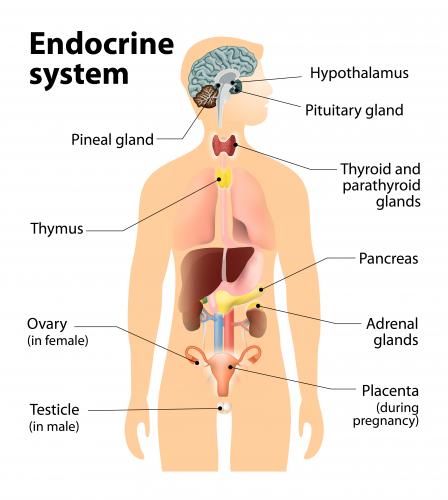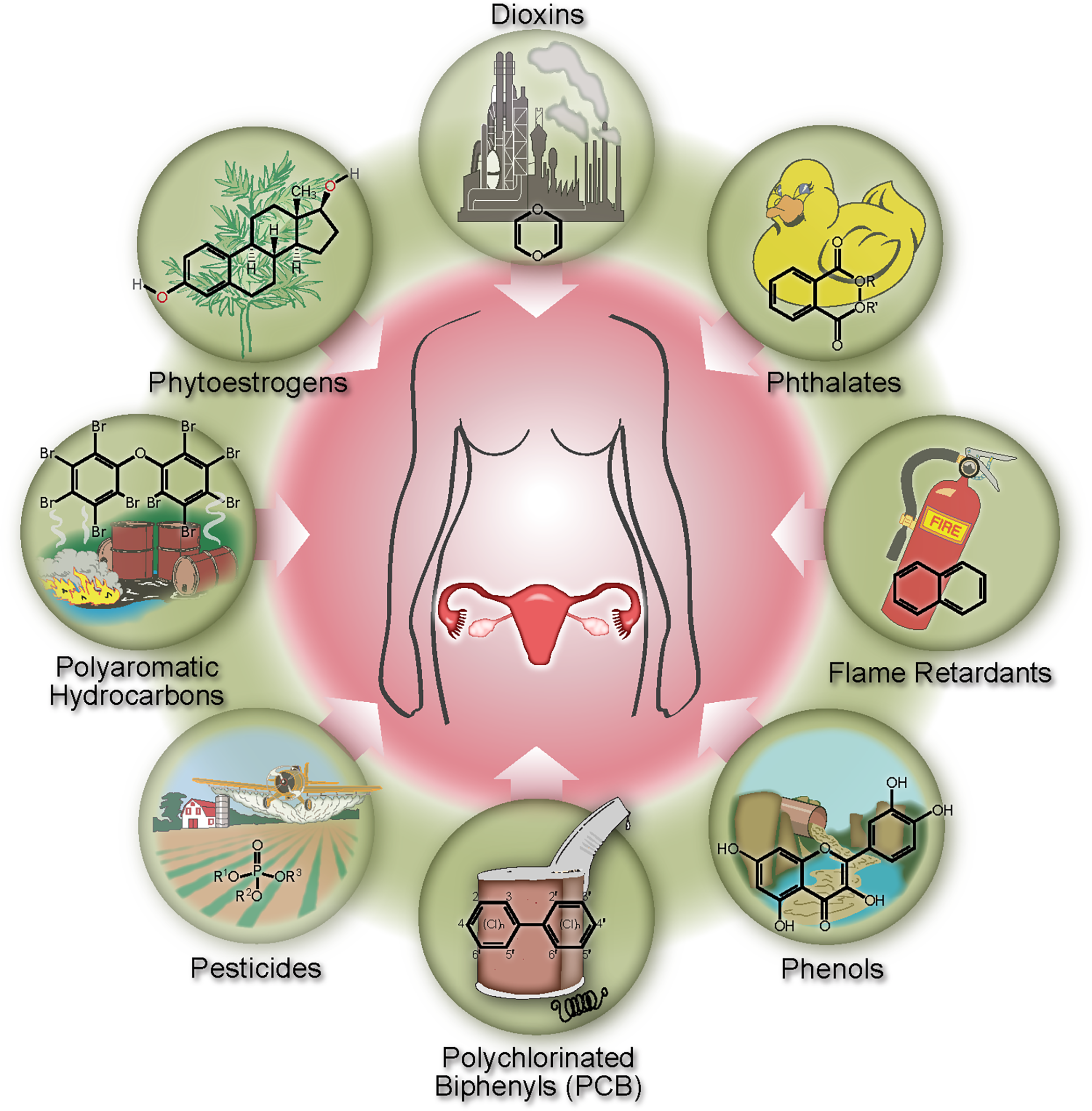Plastic & Public Health Health: Endocrine Disruptors
Key concepts:
• key functions of the endocrine system: regulating metabolism, growth, development and reproduction, and other functions
• test studies with frogs
• Bisphenol A (BPA)
• DEHP [di-(2-ethylhexyl) phthalate] – plasticizer

The Endrocrine System
Some chemicals can mimic hormones, doing so incorrectly and at the same time turning off the body’s natural processes.
The endocrine system is the collection of glands that produce hormones to regulate metabolism, growth and development, tissue function, sexual function, reproduction, sleep, mood, and other functions. The endocrine system comprises all the glands in your body that make hormones, the chemical messaging system that controls the body’s functions.
If your endocrine system isn’t healthy, you could have problems developing during puberty, getting pregnant, or managing stress. You also might gain weight easily, have weak bones, or lack energy because too much sugar stays in your blood instead of moving into your cells where it’s needed for energy.
Studies with frogs have demonstrated radical behavioral changes under the impact of pollutants that act as endocrine disruptors.

Two Top Endocrine Disruptors used in Plastics: BPA & DEHP
Two endocrine disruptors are chemicals widely used in making plastics. Both of these key plastic additives (plasticizers) have endocrine-disrupting properties, bisphenol A (BPA) and di-(2-ethylhexyl) phthalate (DEHP).

Researchers Emily J. North and Rolf U. Halden at Johns Hopkins University Bloomberg School of Public Health and at Arizona State University wrote in 2013, “Detectable levels of [the plastic additive] bisphenol A have been found in the urine of 95% of the adult population of the United States.” The chemical has been restricted in Europe. Along with human and animal health, the financial damage to tourism, recreation, and business has become inestimable.
Awareness of the negative health impacts on children of Endocrine Disrupting Chemicals (EDCs) is growing. According to the Endocrine Society, a growing body of evidence suggests that traditional scientific methods for assessing the health impacts of chemicals are inadequate when assessing EDCs.
BPA is a plasticizer and monomer used in many plastics, such as water bottles, and is also widely used as a building material and in epoxy applications. Industrial manufacturers use BPA in many processes, resulting in its discharge into the environment. Here we see the cross-disciplinary complex systems nature of the plastics problem: solving the BPA problem alone engages the building and construction industry, many other manufacturing processes and products, biodiversity, diet and food, and comes full cycle back to breast-feeding mothers.
BPA in Mother’s Milk
Bisphenol A (BPA) is a known hormone disruptor that attaches to estrogen receptors within the body and has been linked with cancer. Beyond plastic in your drinking water and table salt, plastic is also found as Bisphenol A in mothers’ breast milk and infant urine samples. Researchers tested breast milk of 27 women and urine of 31 infants between three months and 15 months old, screened for environmental exposure to BPA sources. Infants tested had no known environmental exposure outside of a typical household. 93% of urine samples from children and 75% of mother’s milk samples had significant total BPA levels.
Swedish researchers tested BPA levels among 100 women and correlated those levels with their exposure to BPA from their diets: the most prevalent BPA sources come from fish, meat, potatoes, and dairy products.
A 2006 Chemical Heritage Foundation study, conducted on request from Congress, concluded that BPA levels found in humans are enough to cause harm and metabolism changes within many of the body’s tissues and organs. “New research on very-low-dose exposure to BPA suggests an association with adverse health effects, including breast and prostate cancer, obesity, neurobehavioral problems, and reproductive abnormalities.” The BPA health risk is cited as a case study of health policy in the United States. Beyond plastic additives, such as BPA, the tendency of plastics to absorb toxic chemicals adds to the risk. And the coupling of the environment with human health cannot be ignored.
Additives used to make plastics are themselves serious pollutants. Plastics manufacturing releases chemicals, many carcinogenic or neurotoxic, e.g. vinyl chloride from PVC; dioxins and benzene from polystyrene; formaldehyde from polycarbonates; toxins known as persistent organic pollutants (POPs). From arsenic to BPA and DDT, a range of endocrine disruptors disturb the body’s hormone system.
DEHP [di-(2-ethylhexyl) phthalate] – plasticizer
DEHP, like other phthalates, may cause endocrine disruption in males, affecting reproductive function. DEHP is used as a plasticizer in medical devices: blood and dialysis bags, tubing (air, catheters, intravenous, nasogastric, transfusion). Leachates of DEHP may affect patients.
DEHP is used in a great range of products: dolls, floor tiles, furniture upholstery, garden hoses, medical tubing, rainwear, shoes, shower curtains, swimming pool liners, tablecloths, toys, as a fragrance carrier in air fresheners, colognes, cosmetics, laundry detergents, personal care products, scented candles. Our main exposure to DEHP is from food (0.25 milligrams per day). DEHP can leach into drinking water from discharges from rubber and chemical factories. The US EPA limits DEHP in drinking water to 6 ppb. But DEHP is also in bottled water, and the EPA does not regulate levels in bottled water. Because the phthalates are loosely bound to plastic, they are easily absorbed into food, beverages and saliva.
See the app @ earthDECKS.org
Saving Our Oceans from Plastic: articles by Zann Gill
- Adverse Health Effects of Plastic
- Aquaria – Informal Learning Network
- Beat the Microbead
- Bibliography: Plastic Roads
- Boyan Slat: Floater Technology for Ocean Cleanup
- Complex Systems Problems
- Cradle to Grave: Plastic Supply Chain
- Dame Ellen MacArthur: The Circular Economy
- Sylvia Earle: Learning for a Plastic World
- earthDECKS Limelights: Companies to Watch
- Enshrouded in Plastic
- Flamingos Signal the Future We Face
- Floating Trash: More than 4x as bad as we thought
- Give the World a Helping Hand: 3D Prostheses
- Global Ocean Sensing
- Industry Response to the Plastic Challenge
- Nature’s Innovators: plastic consumers
- Ocean Debris Network
- Ocean Ingenuity
- Oceans – Measuring Planet Health
- Plastic Bank – The Exchange Economy
- Plastic – Climate Change Connection: Israel & UBQ
- PLASTIC: Complex Systems Problem
- Plastic: Drinking Water, Table Salt & Mother’s Milk
- Plastic Footprint ~ Carbon Footprint
- Plastic-Eating Enzyme
- Plastic Gyres and Social Justice
- Plastic Impact Calculator
- Plastic Pollution Coalition: Campaign vs Single Use Plastic
- PLASTIC: Overview of National Leadership
- Plastic Roads – Global Innovation Ecosystem
- Plastic Strategies for Innovation
- The Plasticene
- Plastiki: adventure stories & a big message
- Raising Awareness of Plastic Hazards
